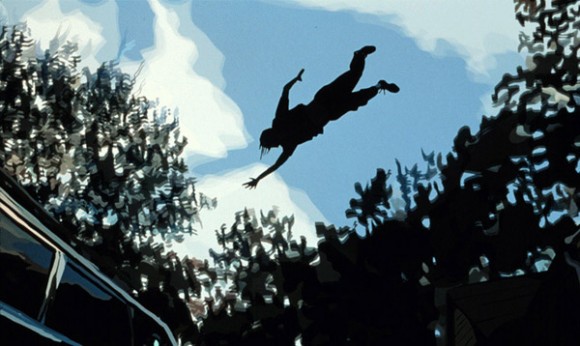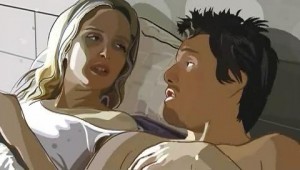
Waking Life is an animated feature film released in 2002, directed by Richard Linklater, the guy who brought us Dazed and Confused and Slacker. This movie is a must-see for anyone interested in dreams, consciousness and how our visionary states play out in modern life.
Like Linklater’s previous works, Waking Life is a film constructed of moments in time, depending more on the viewer’s fascination with the characters’ worldviews rather than a exciting plot sequence. But Waking Life is radically different than his earlier projects, and not just because it’s animated. What makes this film so unusual is the deep philosophical waters it explores as the protagonist (Dazed and Confused‘s Wiley Wiggins), tries to figure out what has happened to him after being hit by a car in the first scene.
The movie can be summed up with this question: Are we sleep-walking through our waking state or wake-walking through our dreams?“
As Wiley goes about his day – which Slacker-style, seems to consist of bumping into strange and talkative people in an American suburban environment –- we are treated to a shifting display of “reality” as Wiley’s consciousness changes moment to moment. Sometimes he’s clear and the animation becomes gritty, laying bare the filmed scene underneath. And other times, the world is a bubbling cauldron of sense impressions that are more dream-like than anything else.
Which is precisely why you should check this movie out if you are into dream studies, and especially movies about dreams. Although the philosophical themes in Waking Life range from “the telescopic nature of evolution” to the existential bummer of modern life (yes, this movie is very “talky” in the tradition of Woody Allen but without the New York anxiety), behind the talk is a meditation on the dream-like qualities of waking life.

How lucid are we anyways?
Because we’re really not as lucid in our waking life as we like to think we are. We are often eclipsed by thought habits and emotional clouds that are almost as old as our bodies, and we co-create the world we are accustomed to being in. As Paul Simon says in the Boxer, “A man hears what he wants to hear and disregards the rest. Lie-da-lie.” But of course we are granted moments of lucidity – those sudden opportunities to break out of our everyday thought addictions – and it is precisely these “aha” moments that Linklater is stalking through his character Wiley.
The film also offers up a fairly base depiction of lucid dreaming as it is most often marketed as in the commercial media. A portly trickster figure tells Wiley how, through “waking up” in his dreams, he can have “so much damn fun.” He leans in and leers, “you can have all the sex you want.” I laughed so hard the first time I saw this, as here is the cultural zeitgeist of lucid dreaming that I am trying my darnest to dispell.
But this character is balanced by other characters who show him how lucidity can be turned, like a mirror, towards deeper questions without losing the exuberance of living passionately.
It’s a beautiful film, in short, even though the dialogue can get tiresome at times. Still, Waking Life is one of the best meditations I’ve seen yet on how our consciousness and our mortality are all tied up in a double helix. I own it on VHS (remember those?) but the DVD includes a short film as well. This movie is a must-have for the dream film collector.
Waking Life can be found at most video rental stores and the occasional switched-on public library. To add it to your collection, it retails for less than $10 on amazon.
I loved this movie! I have seen it several times and always pick up something new. You know the scene where the friend is explaining the phenomenon of lights not turning on? The same day I watched that movie for the first time, I walked into a dark room and flipped the light switch on … and nothing happened. It was just a tad difficult not to leap to conclusions… Turns out it really was just a burnt out light bulb.
There’s some irony in that the effect this movie had on me was peaceful dreamy sleepiness. I tried watching three or four times and never made it to the end.
I haven’t watched the film yet, just a few scenes on YouTube. But this article is reeeeally making me want to watch it. I just checked, and my library has two copies! 🙂
KMG — that is too funny. did you know that the light-switch test for lucid dreaming is a myth tho? I have had LDs where the switches work just fine – this is apparently a case of expectation making the rules of physics.
Danielle – yes, my family have told me the same thing when I made them watch the movie. definitely a movie for the afternoon after a cup of coffee, not late at night after a few cocktails.
Louche – it’s a rare library that carries this movie. but two copies? that’s awesome.
I enjoyed reading that, thank you. I have a Netflix subscription and will see if they have it. Looks really interesting!
I love that movie! I too have watched it many times and every time I am blown away by the dialogue. I wish in my life I could have access to others’ perceptions at every turn.
I was struck by the waking life/dreaming life theme but I was also taken by the theme of one’s very existence, the act of existing and how thinking defines that for us. It’s only when he allows himself to question his thinking, have it be questioned, that he breaks through the wall of reality as we know it into something more awake and alive, which turns out to be ironic.
This movie will be in my collection forever I hope. The main character is a very likable fellow by the way.
“I have had LDs where the switches work just fine”
I’m glad you said that because I have had lucid dreams that I questioned later only because I couldn’t “prove it” to myself. But I definitely have had dreams where I am the prime mover.
Waking Life is absolutely one of my all-time favorite movies!! I’m thrilled you’ve written about it!!
Awesome movie… and not at all what I expected. I especially love the ending 🙂 After this I watched Richard Linklater’s other rotoscoping movie, A Scanner Darkly, based on a story by Philip K Dick – equally as mind-blowing!
There are two kinds of sufferers in this world: those who suffer from a lack of life and those who suffer from an overabundance of life. I’ve always found myself in the second category. When you come to think of it, almost all human behavior and activity is not essentially any different from animal behavior. The most advanced technologies and craftsmanship bring us, at best, up to the super-chimpanzee level. Actually, the gap between, say, Plato or Nietzsche and the average human is greater than the gap between that chimpanzee and the average human. The realm of the real spirit, the true artist, the saint, the philosopher, is rarely achieved.
Why so few? Why is world history and evolution not stories of progress but rather this endless and futile addition of zeroes. No greater values have developed. Hell, the Greeks 3,000 years ago were just as advanced as we are. So what are these barriers that keep people from reaching anywhere near their real potential? The answer to that can be found in another question, and that’s this: Which is the most universal human characteristic – fear or laziness?
Chapter 8-LOVE THIS SCENE.